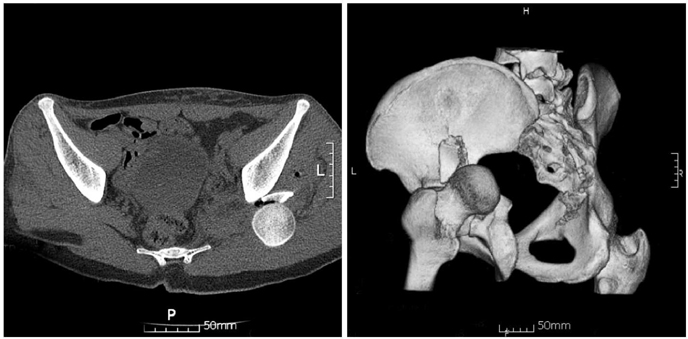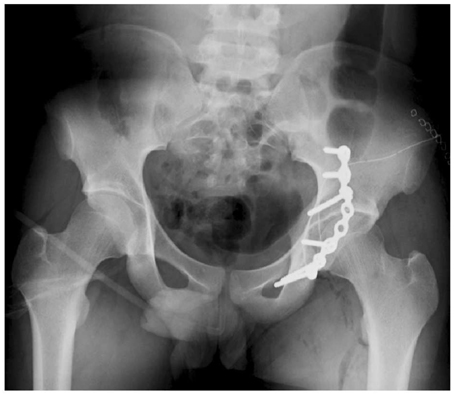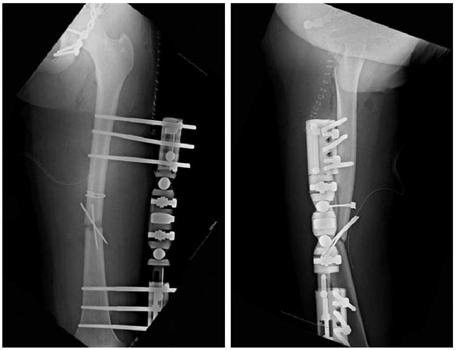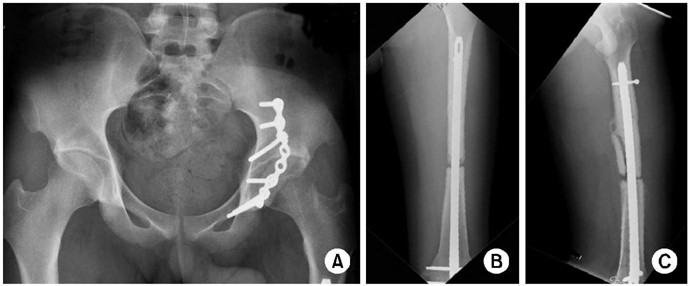J Korean Fract Soc.
2007 Jan;20(1):94-98. 10.12671/jkfs.2007.20.1.94.
Hip Fracture-dislocation with Sciatic Nerve Palsy and Ipsilateral Femoral Shaft Open Fracture: A Case Report
- Affiliations
-
- 1Department of Orthopedic Surgery, Eulji University College of Medicine, Daejeon, Korea. oskkj@eulji.ac.kr
- KMID: 2294387
- DOI: http://doi.org/10.12671/jkfs.2007.20.1.94
Abstract
- The posterior dislocation of the hip accounts for about 85~90% of traumatic hip dislocations and high energy mechanisms such as traffic accidents may cause them. The traumatic dislocation and fracture-dislocation of the hip are true orthopedic emergencies and it should be considered that a femoral head has poor vascularity and the sciatic nerve is closely located to it. We report on one patient who went through the surgical treatment of the concomitant ipsilateral open fracture of the femoral shaft and hip fracture-dislocation accompanying sciatic nerve injury with the review of the literatures.
Keyword
MeSH Terms
Figure
Reference
-
1. Brav EA. Traumatic dislocation of the hip. J Bone Joint Surg Am. 1962; 44:1115–1134.
Article2. Carlsen AW, Lind J. Traumatic dislocation of the hip with ipsilateral fracture of the femur: a method of reduction. Injury. 1991; 22:68–69.
Article3. Epstein HC. Posterior fracture-dislocations of the hip; longerm follow-up. J Bone Joint Surg Am. 1974; 56:1103–1127.4. Epstein HC, Wiss DA, Cozen L. Posterior fracture dislocation of the hip with fractures of the femoral head. Clin Orthop Relat Res. 1985; 201:9–17.
Article5. Harper MC. Traumatic dislocation of the hip with ipsilateral femoral shaft fracture: a method of treatment. Injury. 1982; 13:391–394.
Article6. Hillyard RF, Fox J. Sciatic nerve injuries associated with traumatic posterior hip dislocations. Am J Emerg Med. 2003; 21:545–548.
Article7. Lyddon DW Jr, Hartman JT. Traumatic dislocation of the hip with ipsilateral femoral fracture. A case report. J Bone Joint Surg Am. 1971; 53:1012–1016.8. Schoenecker Pl, Manske PR, Sertl GO. Traumatic hip dislocation with ipsilateral femoral shaft fractures. Clin Orthop Relat Res. 1978; 130:233–238.
Article9. Seddon H. Surgical disorders of the peripheral nerves. 1st ed. Baltimore: Williams and Wilkins Co;1972. p. 299–314.10. Watson Jones R. Fractures and joint injuries. 6th ed. New York: Churchill-Lvingstone;1982. p. 885–934.
- Full Text Links
- Actions
-
Cited
- CITED
-
- Close
- Share
- Similar articles
-
- Combined Femoral and Sciatic Nerve Palsy Associated with Acetabular Fracture and Dislocation: A Case Report
- A Traumatic Anterior Hip Dislocation Associated Ipsilateral Femoral Shaft Segmental Fracture : Case Report
- Traumatic Dislocation of the Hip with Ipsilateral Femoral Shaft Fracture
- Posterior Hip Dislocation with Ipsilateral Fractures of the Femoral Head and Intertrochanter: A Case Report
- Fracture around Hip Joint Combined with Ipsilateral Femoral Shaft Fracture









